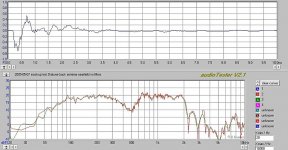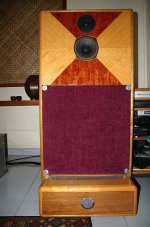In his Summa speaker, Geddes uses a waveguided compression driver down to 1.5kHz, with a pro audio monopole 15" (possibly B&C - I believe the compression driver is B&C also) handling the rest to good effect. Now, Geddes chose the driver size and crossover frequency so that the polar response of both drivers was similar at the crossover frequency.
Dipole radiation is slightly different from the standard monopole radiation which narrows as frequency increases. Off-axis radiation follows cos theta, where theta is the angle from the axis (60 degrees off-axis is -6db). Now, supposing that we choose a driver in dipole operation whose off-axis 45 degree response is -6dB down (as the 90-degree waveguide) at 1.5kHz, AND supposing that its distortion behaviour were the same as the pro audio driver used in the Summa speaker, would we end up with a speaker that sounded better in most rooms?
Dipole radiation is slightly different from the standard monopole radiation which narrows as frequency increases. Off-axis radiation follows cos theta, where theta is the angle from the axis (60 degrees off-axis is -6db). Now, supposing that we choose a driver in dipole operation whose off-axis 45 degree response is -6dB down (as the 90-degree waveguide) at 1.5kHz, AND supposing that its distortion behaviour were the same as the pro audio driver used in the Summa speaker, would we end up with a speaker that sounded better in most rooms?
Too many ifs and buts  ... You may achieve a better matching of dispersion patterns, but who knows what sounds "best" to whom?
... You may achieve a better matching of dispersion patterns, but who knows what sounds "best" to whom?
Anyway, I've been interested in the same basic question. My 2 cents:
AFAIK dipole results in 45 deg: -3 dB and 60 deg: -6 dB.
I see 2 somehow separate issues: dispersion in listening direction, and power response in room.
First dispersion: Using a tweeter horn with the same radiation pattern as a dipole, you'd match dispersion on and off axis in the listening direction, to a dipole mid/woofer.
But this is not the whole picture. For a good balance in room, you'd still have to match power response though. And here the horn solution has a problem.
A regular dome tweeter above baffle step will gain 6 dB on axis, from going from full-space to half-space radiation on a baffle. So it needs to be padded down 6 dB in SPL output for flat on axis SPL. This means the power response of the tweeter into the room is already -6 dB w/regards to an omnipole. The dipole is -4.8 dB vs the omnipole. So a woofer dipole is actually quite a good match in radiated power, to a regular dome tweeter on a flat baffle: the tweeter is -1.2 dB in radiated power w/r to the dipole woofer, quite acceptable. In fact it may not even have a full 6 dB baffle step gain, so the difference to the woofer's power response is academic.
Now, if you used just a front firing horn tweeter, you'd get ideal dispersion matching, but much less tweeter power response into the room, than you do with the woofers. You'd have to add a rear firing horn tweeter to get your radiated power rersponse back. And this, according to some people, creates more issues with specular reflections and room unevenness, than it solves (I don't claim experience in this area - my tweeters are ordinary monopoles, my mids and woofers dipoles).
I assume this is why SL prefers monopole tweeters radiating into half space, even though in the crossover region there is some fudge factor and baffle shape experimentation to do, to match the dispersion characteristics.
Anyway, I've been interested in the same basic question. My 2 cents:
AFAIK dipole results in 45 deg: -3 dB and 60 deg: -6 dB.
I see 2 somehow separate issues: dispersion in listening direction, and power response in room.
First dispersion: Using a tweeter horn with the same radiation pattern as a dipole, you'd match dispersion on and off axis in the listening direction, to a dipole mid/woofer.
But this is not the whole picture. For a good balance in room, you'd still have to match power response though. And here the horn solution has a problem.
A regular dome tweeter above baffle step will gain 6 dB on axis, from going from full-space to half-space radiation on a baffle. So it needs to be padded down 6 dB in SPL output for flat on axis SPL. This means the power response of the tweeter into the room is already -6 dB w/regards to an omnipole. The dipole is -4.8 dB vs the omnipole. So a woofer dipole is actually quite a good match in radiated power, to a regular dome tweeter on a flat baffle: the tweeter is -1.2 dB in radiated power w/r to the dipole woofer, quite acceptable. In fact it may not even have a full 6 dB baffle step gain, so the difference to the woofer's power response is academic.
Now, if you used just a front firing horn tweeter, you'd get ideal dispersion matching, but much less tweeter power response into the room, than you do with the woofers. You'd have to add a rear firing horn tweeter to get your radiated power rersponse back. And this, according to some people, creates more issues with specular reflections and room unevenness, than it solves (I don't claim experience in this area - my tweeters are ordinary monopoles, my mids and woofers dipoles).
I assume this is why SL prefers monopole tweeters radiating into half space, even though in the crossover region there is some fudge factor and baffle shape experimentation to do, to match the dispersion characteristics.
It's something I'd also like to know. I recall from Linkwitz website that a driver in an open baffle will have wider dispersion than it would as a monopole, hence if the monopole had dispersion matched, the dipole would not be, without alteration.
One interesting aspect is that OB can give 6db increased efficiency in the midrange, just as a waveguide can do the same for a tweeter.
One interesting aspect is that OB can give 6db increased efficiency in the midrange, just as a waveguide can do the same for a tweeter.
MBK said:Too many ifs and buts... You may achieve a better matching of dispersion patterns, but who knows what sounds "best" to whom?
Now, if you used just a front firing horn tweeter, you'd get ideal dispersion matching, but much less tweeter power response into the room, than you do with the woofers.
Perhaps a U-frame dipole midrange driver, with the back stuffed so that there's less and less radiation as frequency increases until there's almost zero energy radiating out the back? Possible at above 1kHz? 2kHz? Then, like the waveguided tweeter, there would be negligible rear-firing sound but at the same time the lower end of the passband would operate in dipole mode which would make it easy to blend with a dipole (mid)bass driver.
Well, this would work in the crossover region, but you still have the problem of nonuniform power response of the system as a whole, as you move up frequency.
Interesting enough, in my system (shallow U-frame for mids, no stuffing at all), the rear radiation of the mid (a fullrange employed as a mid, 160-1600 Hz) drops to almost nothing >2 kHz... See attached nearfield FR of the open back. Also observe the deep first null - this was a test baffle that was a bit too symmetrical...
Interesting enough, in my system (shallow U-frame for mids, no stuffing at all), the rear radiation of the mid (a fullrange employed as a mid, 160-1600 Hz) drops to almost nothing >2 kHz... See attached nearfield FR of the open back. Also observe the deep first null - this was a test baffle that was a bit too symmetrical...
Attachments
Member
Joined 2003
This one used the "gradual transition from dipole to monopole" approach by rolling off the backwave with a thick felt filter across the rear of the baffle. I liked the result a lot...but I also think none of us has found the "magic bullet" for every environment.
MDF is cheap, and drivers reusable, so start trying your ideas!
MDF is cheap, and drivers reusable, so start trying your ideas!
An externally hosted image should be here but it was not working when we last tested it.
Since I have never heard Dr Geddes speakers, I have no clue whats better, or best,etc. I can only say I like mine. Designed for my room. Thats good enough for me . I do follow his work however. Good stuff.
. I do follow his work however. Good stuff.
cheers,
AJ
cheers,
AJ
An externally hosted image should be here but it was not working when we last tested it.
Isn't lobing a problem with that kind of design?Paul W said:This one used the "gradual transition from dipole to monopole" approach by rolling off the backwave with a thick felt filter across the rear of the baffle. I liked the result a lot...but I also think none of us has found the "magic bullet" for every environment.
MDF is cheap, and drivers reusable, so start trying your ideas!
An externally hosted image should be here but it was not working when we last tested it.
Member
Joined 2003
Not sure if I'm answering the right question...but increased vertical directivity (restricted radiation) was but one of the objectives with the symetrical array. That worked except for bass (longer wavelength) and above tweeter xo. Or are you asking something about the backwave?
Member
Joined 2003
Yes, you are correct. That was one of the tradeoffs vs 2X power handling, reduced excursion/distortion, reduced floor and ceiling bounce. The successor version is smoother. (Note drivers really are reusable  )
)
An externally hosted image should be here but it was not working when we last tested it.
Member
Joined 2003
They don't depreciate (if you keep them), but they sure don't appreciate.
Well, unless they are Tannoy Golds or Reds or......

http://cgi.ebay.com/TANNOY-Rare-Pai...ryZ50597QQssPageNameZWDVWQQrdZ1QQcmdZViewItem
Cheers,
AJ
- Status
- This old topic is closed. If you want to reopen this topic, contact a moderator using the "Report Post" button.
- Home
- Loudspeakers
- Multi-Way
- Blending controlled directivity treble with dipole midrange?


